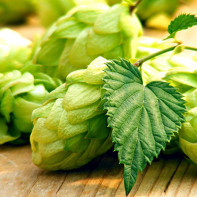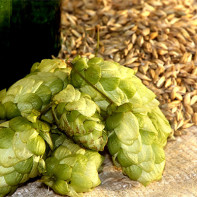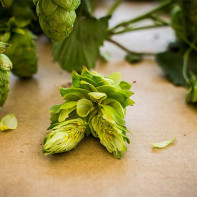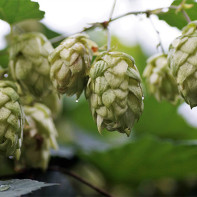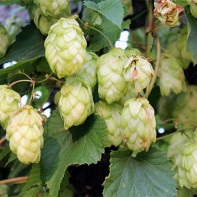Hop cones: medicinal properties and contraindications
Hops in many are associated with brewing. But in fact, ordinary hop is also a medicinal plant, and its unique properties were known in antiquity, but only recently have they been confirmed by scientific research.
- Botanical description of the plant
- Where does hops grow and how is it used
- Chemical composition
- Collection and storage
- The healing properties of hop cones
- For women
- For men
- During pregnancy
- For kids
- Hop cones in folk medicine
- Types of healing compounds
- Infusion
- Tincture
- Decoction
- Tea
- Ointment
- Butter
- Application in cosmetology
- Contraindications
Botanical description of the plant
The scientific name for common hop is Humulus lupulus L., a perennial herb that, from a botanical point of view, is a climbing vine. Hops have a powerful and highly branched creeping rhizome, with thick roots that grow rapidly. The underground part of this creeper hibernates well and can generally grow in one place for up to 20 years.

The aerial part is annual shoots of a tetrahedral shape covered with small hooked spikes. They grow to 3–6 m. The shoots grow very quickly. In a day, the stem can grow by 20 cm. The shoots are covered with rough leaves with glands.
Hop - a dioecious plant, that is, male and female individuals are found. And the flowers on them are different. Hop cones - these are just the flowers that form on female plants (and not fertility, as many are used to saying). These dense cones on average consist of no less than 20 flowers (and sometimes there are up to 60 pieces). On the lower part of these cones there are lupulin glands, which contain bitter substances (we will discuss them below).
On male plants there are no cones, only inflorescences in the form of leafless panicles. Interestingly, very often only female plants are bred for industrial needs. This is necessary so that they are not pollinated, and fruits do not appear on them. The fact is that the appearance of fruits reduces the value of hops, since the number of lupulin glands in such cases decreases on its cones.
Where does hops grow and how is it used
Common hops in the wild are widespread in Europe and North America, and are found in some regions of Africa. But in Central Asia it is very small. In nature, hops often grow near rivers and in the steppes, as well as in forest zones. But nowadays it is much easier to find its cultural varieties.
Hops are grown on an industrial scale in almost all European countries, Mexico and the United States. Over the centuries, many varieties of this plant have been bred. Among themselves, they differ in the shade of the stem, the time of flowering and ripening, as well as the content of bitterness in the cones. Hops can also be cultivated in a personal plot - it requires fertile soil and protection from northern winds, but in general its cultivation should not cause special difficulties.
On the site, hops as a climbing plant are often used in landscape design - it looks good on slopes, pillars of arbors and pergolas. Hop cones are widely used in the food industry, and not only in the brewing, but also in the baking industry - there they make liquid yeast for some varieties of bread. The composition of hop cones includes tannins - they prevent souring of drinks and products obtained from it.
And in the old days, hop cones were often used for dyeing fabrics, while fiber was made from its long stems, from which later ropes and a rough burlap were made.
Chemical composition
Hop cones contain unique substances - for example, lupulin and other hop acids. Their chemical composition is quite diverse. It includes:
- Polyphenolic compounds, including flavonoids, with antioxidant and anti-inflammatory activity.
- Phytohormones, mainly estrogen-like substances.
- Essential oil is light yellow in color, which in itself has a fairly complex chemical composition. Its main active ingredients are myrcene and myrcenol, which have a pleasant aroma. It also contains esters of acetic and formic acid, linalool, geraniol, etc.
- Bitterness (or tarry substances). In total, about 90 compounds of this kind are included in the cones, including lupulin, humulon and others. The composition of hop cones can be up to 26% bitterness, their number depends on the specific variety.
- B vitamins, which have a positive effect on the state of the nervous system and activate metabolic processes.
- Vitamin PP, which has a beneficial effect on the state of blood vessels.
- Ascorbic acid, which is also an antioxidant, and in addition - strengthens the immune system.
- The alkaloid-like substance is humulin.
- A large number of salts of iron, potassium and calcium, which are involved in many vital biochemical processes in the human body.
It is the presence of these substances that determines the healing properties of hops. For example, flavonoids, as well as vitamins C and PP strengthen blood vessels and have an antiulcer effect. Bitterness has a beneficial effect on digestive processes. Polyphenolic compounds neutralize the negative effects of free radicals and inhibit oxidative processes, which could lead not only to premature aging, but also to the development of various inflammatory processes and even atherosclerosis and the growth of tumors of various kinds.
Collection and storage
For medical purposes, mainly hop cones, that is, inflorescences of female plants, are used. Their collection in most regions is carried out in September, when the inflorescences should already have completed their growth - then the first signs of yellowing become noticeable on them. It is believed that it was at this time that the concentration of bitterness and lupulin in particular reached its maximum. Do not delay the cleaning, since there is a risk that the yellowed cones will begin to crumble, and this will lead to the loss of part of lupulin.
Hops are collected exclusively by hand. Cones are torn off along with the stalks. They are dried at room temperature, in a well-ventilated room, laid out on paper (but not on newspapers, so that printing ink is not absorbed) or on a light cloth. You can dry in the fresh air, but only in the shade. The whole process takes several days. Finished raw materials are stored in paper bags so that aromatic substances do not evaporate, at a normal level of humidity, in a closet, away from sunlight. Under the influence of ultraviolet radiation, oxidative processes begin, an unpleasant odor arises due to the destruction of certain substances, the taste spoils, but most importantly, the raw material quickly loses its healing properties.
The healing properties of hop cones
The pharmacological properties of hop cones are very diverse. In particular, preparations based on them:

- They have anti-inflammatory properties.
- Accelerate tissue regeneration.
- Normalize the state of blood vessels and improve blood counts.
- They have a diuretic effect (its intensity is largely determined by the variety of hops).
- They increase the production of gastric juice without increasing its acidity.
- They speed up the metabolism.
- They prevent the development of cirrhosis of the liver (this is how bitter hop acids act), in general, the plant has hepatoprotective properties, protecting this organ from the negative effects of alcohol.
- They have antiseptic properties. The bitterness contained in the cones inhibits the development of some fungal cultures and destroys others, and they also have a detrimental effect on many gram-negative bacteria and even some acid-resistant microorganisms. However, concoctions of cones alone cannot replace the antibiotics obtained industrially, but enhance their effect.
- They have a sedative effect on the central nervous system (not only the bitterness of lupulin, but also other components of the essential oil is responsible for this). However, this plant gives a calming effect not too strong, especially since it is also caused by volatile alcohol, and its concentration increases gradually after drying, reaching a maximum only at the end of the shelf life. Therefore, to enhance the sedative effect of hop cones are often used in combination with other plants, such as valerian.
- They have an antispasmodic effect, including beneficial effects on intestinal muscles.
Studies have also shown that hop cones positively affect not only lipid but also water metabolism.
For women
In addition to the properties listed above, women are interested in hop cones because of the ability of this plant to treat gynecological diseases and even increase breasts. The fact is that in these cones there is a large amount of a hormone-like substance - phytoestrogen 8-PN. It is used for the manufacture of medicines and various cosmetics. The substance acts in the same way as the female hormone estrogen.
Apparently, this action of his explains the ability of hop cones to increase breasts. In folk medicine, an infusion is used for this purpose - 1 tbsp. spoon of hop cones (you can buy them at the pharmacy) in a glass of water. The product is brought to a boil and left on low heat for 10-12 minutes. After that, the drink is left in a container under a closed lid for 6-8 hours. The finished product is drunk twice a day for half an hour before meals, 1/2 cup. The duration of the course is at least 2-3 weeks. After this period, the first results will be noticeable.
It is believed that when using this infusion, you can increase the breast size by 1-2 sizes in a relatively short period of time. However, you need to understand that hop cones are not the most harmless remedy, they have a number of contraindications, and you must first consult a doctor, as weight gain is one of the easiest consequences of an overdose of such an infusion, and in the worst case, its use can lead to hormonal a failure. The doctor will most likely direct you for tests, and if estrogen levels are already high, hop cones will be contraindicated.
More recently, studies have been conducted that have shown that hop cones contain a substance such as xanthohumol. When brewing beer, it forms metabolites. The latter have antitumor activity. These metabolites are also formed during digestion. Their main property is the ability to reduce estrogen synthesis and prevent the development of malignant neoplasms in the mammary glands. Xantohumol prevents the proliferation of cancer cells and prevents the appearance of metastases.
For men
For the stronger sex, hops as a medicinal plant are interesting, first of all, for their antibacterial and anti-inflammatory properties (due to this, cones can be used to treat prostatitis and urethritis).
Studies have shown that flavonoids contained in hop cones suppressed the development of malignant prostate tumors. In addition, the xantohumol described above had an inhibitory effect on cancer cells, i.e., it slowed down the development of such neoplasms.
The calming properties of hop cones make them useful for severe stress and neurosis, which most men are exposed to today. In addition, the sedative effect of this plant is used in the treatment of premature ejaculation. At the same time, a decoction of hop cones contributes to the production of testosterone, which allows you to normalize an erection.
Phytohormones contained in hop cones help stop baldness and also effectively fight some diseases of the urinary system.
During pregnancy
Due to the fact that hop cones contain phytoestrogens, and the hormonal level of expectant mothers undergoes strong changes during pregnancy, it is impossible to take preparations based on hop cones at this time. This also applies to lactation.The fact is that estrogens inhibit milk production.
For kids
Preparations based on hop cones are contraindicated in young children. In general, it is better not to give them to babies under the age of three, unless the potential benefit of this plant will exceed the possible negative consequences. Some experts believe that children based on hop cones cannot be used at all.
Hop cones in folk medicine
In folk medicine, hop cones have been used since ancient times. There are ancient Arabic treatises that recommend the use of this medicinal raw material as a choleretic agent, as well as for the purification of blood. Given the diuretic effect, which helps to eliminate toxins from the body, it should be noted that the eastern healers were right about the effects of hops. But the famous European doctor Paracelsus believed that hops are an excellent remedy for diseases of the stomach - and modern science has also proved its correctness.
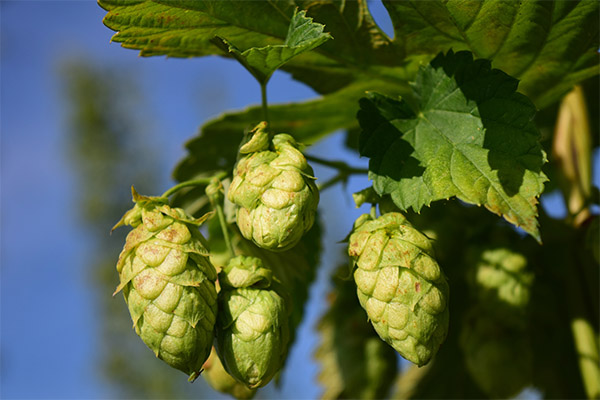
In folk medicine of different countries, hop cones are recommended for epilepsy, various neurological disorders (including neurasthenia, insomnia, headache, neuralgia). The inflorescences of this plant are also used as a remedy against cardiovascular diseases - for example, with arrhythmia, cardioneurosis, heart failure. Hops relieves swelling, helps to normalize blood pressure.
In ancient times in Russia, hop cones were used in the treatment of jaundice. However, in fact, this disease has a viral nature, and the plant cannot eliminate its cause (it is effective only for bacterial infections). So, hop cones in hepatitis do not replace drug treatment, which includes modern drugs. But they have a beneficial effect on the liver, so they can become part of complex therapy.
Infusions and decoctions of hop cones are also used in the treatment of gynecological diseases, both inflammatory in nature and those associated with hormonal imbalance. For example, during menopause, when there is a decrease in estrogen production, hop cones will help replace hormone replacement therapy. Also, traditional medicine recommends drugs based on them for menstrual irregularities.
Means for external use are also made from hop cones. These are decoctions, infusions and ointments that help with burns, fungal skin diseases, purulent wounds and even scabies.
Thus, hop cones are used both for treatment and for the prevention of diseases. Moreover, their spectrum is wide enough, as was shown above. Specific recipes will be given below. For example, hop cones are used:
- With disorders of the central nervous system, accompanied by increased excitability, as well as with epilepsy. In such cases, either an infusion of cones, prepared according to the recipe described below, or less concentrated hop tea is used - 1 teaspoon of dried raw materials per glass of boiling water. If you drink 2 cups of such tea per day, it will act as a mild sedative. If you drink a cup of tea at night, it will save you from insomnia.
- Against colds and diseases accompanied by cough. 2 cups of tea prepared according to the recipe described above are drunk per day. Against coughing, rubbing the chest is also effective with either essential oil obtained from hop cones or vegetable oil infused with this raw material.
- With gout, fresh or dried hop cones are crushed and ground with butter or other fat that can be used for medical purposes. It turns out the ointment, which lubricate diseased joints. It does not remove the causes of gout, which are a violation of salt metabolism, but relieves pain and inflammation.Also, with gout and rheumatism, baths based on the infusion or decoction of hop cones are shown. Take them no longer than 15 minutes.
- With eczema make an infusion of hop cones, and cook it in a water bath - take 1 tbsp. a spoonful of raw materials in a glass of boiling water and heated for 20 minutes over low heat, putting a container with this liquid in a saucepan with water. Then the product is cooled, filtered and lotions made of it, moistening cotton pads in it, which are then applied to problem areas of the skin.
- With seasickness, they drink tea from hops - a cup a day will be enough, you need to drink a little, in small sips.
- For headaches, a decoction is prepared on the basis of clover and hop cones. To do this, take 1 teaspoon of each component in 1.5 cups of boiling water. The product is brought to a boil again, insisted for an hour, filtered, and then drunk before breakfast, lunch and dinner, 70 ml.
- With inflammatory diseases of the kidneys, an infusion is prepared. Take 1 tbsp. a spoonful of dried cones, chopped, pour 1 liter of boiling water and heated in a water bath for 15 minutes. It turns out a low concentration product, which is taken 70 ml three times a day, immediately before meals, with a glass of water. It should be borne in mind that the infusion acts like a diuretic.
- In the treatment of gastritis with low acidity and inflammatory diseases of the gall and bladder, the infusion is prepared as follows - take 1 tbsp. a spoonful of cones in a glass of boiling water, the product is then heated in a water bath for 15-20 minutes, not bringing to a boil. Then the infusion is removed from the heat, cooled, filtered and taken in 50 ml twice a day (but not at night - taking into account its diuretic effect).
- With neuralgia, make an infusion: crush 1 tbsp. spoon of dried hop cones, pour 0.5 l of boiling water and leave for an hour in a closed container. After that, the finished product is filtered and taken in 100 ml before each meal.
- With back pain caused by osteochondrosis and other pathologies of the spine, as well as with bruises, prepare such a decoction. Take 1 tbsp. spoon of dry raw materials, pour 200 ml of freshly boiled water and insist on a water bath for another 15 minutes. You do not need to drink this infusion. Compresses are made from it, which are applied to problem areas. Such a compress is kept until it cools.
- In case of allergies, a preparation is prepared as follows - take 2 teaspoons of dried cones in a glass of boiling water, then, not bringing to a boil, just heat over low heat for 10-15 minutes, leave until it cools down to an acceptable temperature, then filter and take 3-4 times a day, 50–70 ml.
- With liver diseases, take 2 tbsp. tablespoons of juice obtained from fresh hop cones are mixed with 200 ml of hot water and the same amount of boiled milk and drink 1 cup of the product per day. In winter, juice can be replaced with an infusion of hop cones - 2 tbsp. tablespoons of crushed raw materials for the same amount of water and milk. Insist the remedy for 7-8 hours, best left in a thermos for the night.
And the simplest herbal medicine based on hop cones is obtained even without heating and preparing infusions and decoctions. In order to cope with insomnia, it is enough to place the dried hop cones in a linen bag and place it in the bedroom instead of a sachet. The sedative effect is achieved due to the content of lupulin and valerianic acid. Such a tool can be used by those who are contraindicated to drink a decoction.
Some folk recipes suggest stuffing hop cones with pads designed specifically for sleeping - but this way the body gets an overly large dose of essential oil.
Types of healing compounds
In folk medicine, various types of agents based on hop cones are used - these are infusions, decoctions, and ointment. The choice of a particular option depends mainly on what kind of disease it will be used against.
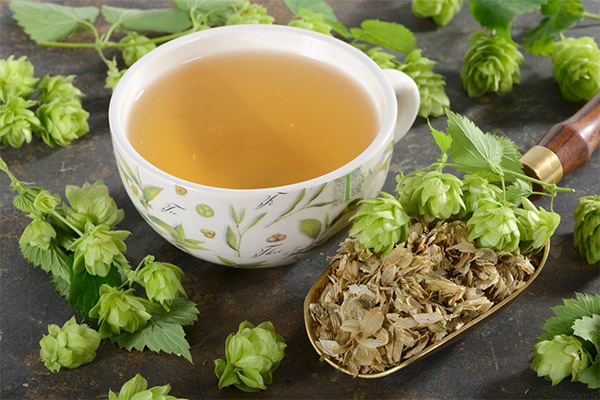
Infusion
This dosage form is often used to combat insomnia or treat neurological diseases. There are many recipes. The simplest option would be this - take 20 g of crushed cones per 0.4 l of boiling water and insist for 2 hours. After that, the tool is filtered.The maximum concentration of the infusion can be 1:10, no more, otherwise an overdose will occur.
The infusion can be used both for internal and external use. For example, it can be added to an evening bath with warm water. A couple of drops of lavender oil will help strengthen its effect. Such a calming procedure is recommended to be carried out regularly, at least 5 times a week to achieve a stable result.
Tincture
This tool is prepared in vodka or alcohol solution. Take 1 tbsp. a spoonful of crushed dry cones and pour a glass of vodka or 40% alcohol solution. The container is left in a dark place for 10 days. Shake its contents periodically. At the end of this period, the contents of the container are filtered and poured into a dark glass bottle. Take such a tincture only 10-15 drops per day, washed down with a small amount of water. In ancient times, it was considered an excellent anthelmintic. It helps with various gynecological disorders.
Decoction
There are many recipes. The most effective as a sedative is a decoction prepared without heating in a water bath. To do this, take 1 teaspoon of dried cones per 100 ml of boiling water. This product is poured into a jar and put in a pot of hot water for 15 minutes, after which it is filtered and taken at night, one hour before going to bed. A cup will be enough if you drink more - the diuretic effect will interfere with sleep.
Tea
This remedy differs from ordinary infusion in a lower concentration. Take 1 teaspoon without a slide of plant material in a glass of boiling water and insist for 15 minutes. To improve the taste, honey is added to the drink, because without it, the taste will seem too bitter. If you are not sure that the hops will not cause an allergy, you can start with a weaker concentration - 1 hop cone per glass of boiling water.
Ointment
To prepare the ointment, take 2 tbsp. tablespoons of cones per 100 g of unsalted butter. Hop cones are pre-crushed, then mixed very carefully with fat. Such a tool is stored only in the refrigerator. It is considered effective in various skin diseases.
Butter
Hop essential oil can be found in pharmacies and in stores selling organic products. But in folk medicine, a recipe for oil from hop cones is common, which in fact is its oil extract, that is, an extract containing the maximum concentration of nutrients.
To prepare this product, take a glass jar (half a liter is enough). This container is filled with chopped or even better - crushed hop cones, which are then poured with vegetable oil. It is best to take refined olive, but sesame and even sunflower will do. The oil is then left to infuse. They keep it in a dark place, since under the influence of sunlight it can oxidize. When the hops settle to the bottom, a little free volume will appear in the tank, add more oil. Once a day, the contents of the jar are shaken. Insist product for 2 days. After that, it is filtered and left for another 3 days. And after this period, the oil is considered ready.
This tool is most often used to enlarge the breast. It is applied to the skin of the bust and décolleté with light massage movements. In this case, the oil itself does not need to be heated, but it is better to apply it on a previously steamed body. Since, like any other herbal remedy, it can cause allergies, first you need to check it on a small area of the skin. If discomfort, itching, or burning occurs after applying the oil, you cannot continue to use it.
Oil can also be used for skin care. Like ointment, it has a wound healing effect, can be used to regenerate tissues, to nourish the skin (because it contains many vitamins and amino acids).
Application in cosmetology
The unique chemical composition of hop cones makes them an excellent cosmetic product that can significantly improve the condition of the skin and hair. You can find a ready-made extract of hop cones or make it yourself (for example, prepare an infusion).Adding a small amount of infusion to a regular hair shampoo will help get rid of seborrhea and make the curls more shiny and silky. Alcohol tincture can be added to a face tonic designed to treat acne.
And, of course, infusions and decoctions of hop cones can be used as an independent means. For example, they will help cure acne and soothe irritated skin. To do this, take 1 tbsp. a spoonful of cones, pour a glass of boiling water and insist for 60 minutes. The finished product is passed through cheesecloth and used for daily washing. This infusion is used instead of tonic - it removes the oily sheen from the skin, helps to narrow the pores.
You can make cosmetic ice from it and wipe it with cubes of skin. The flavonoids contained in this broth will remove inflammation and restore freshness and youth to the skin. Ice does not just cause narrowing of pores, it improves blood microcirculation, and vitamins, minerals and nutrients contained in hop cones make the procedure especially effective.
Cosmetic masks can be prepared on the basis of dried hop cones by mixing this raw material, for example, with kefir or sour cream. Such a mask whitens the skin, relieves inflammation, promotes the production of collagen and even fights wrinkles.
At the same time, hop cones can be well combined with other natural ingredients that are widely used in home cosmetics - for example, with lavender, olive and almond essential oils.
An infusion of hop cones prepared according to the classical recipe (20 g of cones per 0.4 l of boiling water) can be used to rinse hair after washing your hair. The lupulin contained in it soothes irritation on the scalp, eliminates unpleasant itching, removes dandruff, has a beneficial effect on the hair after dyeing, restoring and strengthening their natural structure.
Against dandruff and hair loss, a stronger solution is sometimes prepared in a 1: 3 ratio (for example, 100 g of plant material per 300 ml of boiling water). This remedy is insisted for an hour, filtered, and then rubbed into the scalp with massage movements before washing - this will ensure blood flow, and nutrients are better absorbed.
Contraindications
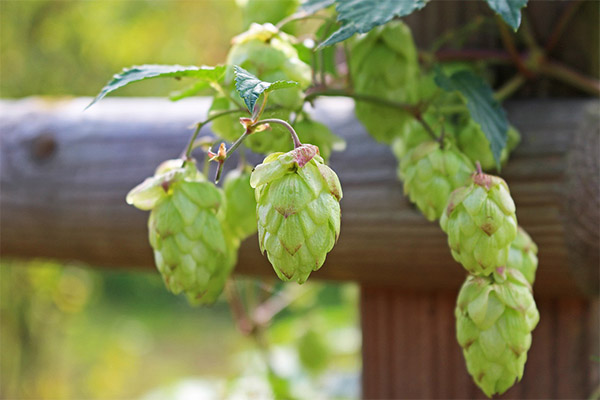
Hop cones can cause allergies, so they are contraindicated in people with hypersensitivity to this plant.
The use of hop cones is contraindicated in gastritis with high acidity, gastric ulcer, reflux esophagitis. Although they themselves do not cause an increase in acidity levels, in these diseases, increased production of gastric juice in itself can lead to unpleasant consequences.
It is very important to observe the correct dosage of hop cones. The fact is that in large quantities they can cause poisoning, which is accompanied not only by general malaise, but also severe vomiting and headache.
In addition, hop cones contain phytoestrogens. And in excessively large quantities, this can lead to obesity and other unpleasant consequences like endometrial hyperplasia, sometimes even with vaginal bleeding.
Side effects of hop cones include not only hormonal disruptions, but also drowsiness, increased appetite, and the appearance of vaginal discharge. If any of the listed phenomena occurs, you must stop taking the drug and consult a doctor for advice.
«Important: all information on the site is provided exclusively in fact-finding purposes. Before applying any recommendations, consult with a profile specialist. Neither the editors nor the authors are liable for any possible harm caused materials. "

